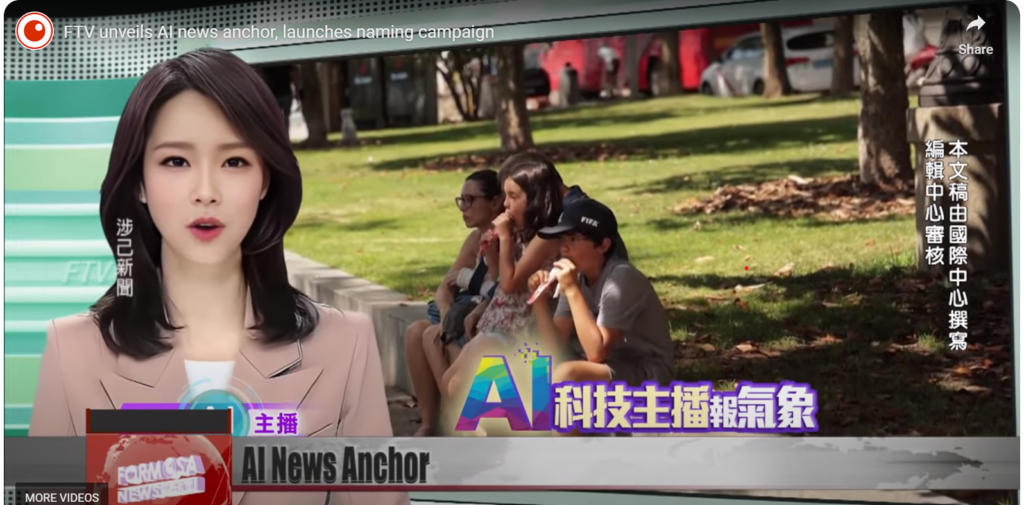
The region is witnessing the rise of AI news bots that have started reading bulletins in countries, often to help cater to diverse cultural and linguistic needs.Source: Shutterstock
More countries across Asia are introducing AI news anchors. Here’s a list
|
Getting your Trinity Audio player ready... |
- India Today launched a female AI news anchor called ‘Sana’ in April.
- Odisha TV, an Odia-based news station, unveiled “Lisa,” India’s first regional AI news anchor.
- Indonesia’s TVOne channel also introduced two AI news anchors in three months.
In 2018 China made a move it claims to be the world’s first – introducing an artificial intelligence (AI) news anchor. The move was unlike any other, and according to China’s state news agency, Xinhua, the virtual newsreader was meant to “work” 24 hours a day on its website and social media channels, “reducing news production costs.”
That was five years ago, and for Xinhua’s already tightly-scripted and controlled state news presenters, the AI anchors would take things a step further. But journalism generated by machines is still nascent for the industry, and it’s unsurprising China was at the forefront of the evolution.
With the rise of AI in many forms, like generative AI, the use of technology has become part of the industry’s toolbox. Four years ago, Francesco Marconi, the head of research and development at The Journal, told the New York Times AI had become a necessity.
“I think a lot of the tools in journalism will soon be powered by AI,” Marconi predicted in 2019. He wasn’t wrong – in an era of ChatGPT, newsrooms worldwide are starting to grapple with how they will incorporate the technology into their workflows and workplaces.
Take Asia, for instance – the region is witnessing the rise of AI news bots that have started reading bulletins in countries, often to help cater to diverse cultural and linguistic needs.
India’s AI news anchors
Following China’s state-run Xinhua news agency launch of two AI news anchors in 2018, one speaking Chinese and the other speaking English, India followed suit this year. The South Asian nation launched its first AI-powered anchor, Sana, in April.

Odisha’s first AI news anchor. Source: Twitter
Sana occasionally presents bulletins on the India Today Group’s Aaj Tak news channel. Just last week, Sana made history on Aaj Tak’s prime-time show by presenting a news report entirely in French, marking a significant milestone in the country’s field of broadcasting.
Sana’s latest abilities coincided with Prime Minister Modi’s visit to France. It holds special significance as it commemorates the 25th anniversary of the strategic partnership between India and France. Joining the trend, several other channels nationwide have also introduced their AI-powered news presenters.
Last week alone, two AI news presenters debuted in India. Lisa appeared on the private news channel in Odisha, presenting bulletins in English and Odia – a language spoken in the state.
The channel’s leader Jagi Mangat Panda called the moment “a milestone in broadcasting TV and digital journalism” and said ‘Lisa’s’ role would involve doing repetitive work “so news people can focus on doing more creative work to bring better quality news.”
‘Lisa’ will be able to deliver news in various local Indian languages. Even India’s Power TV, a Kannada channel, made a similar groundbreaking move. The channel introduced its very own AI presenter, Soundarya.
Indonesia

TVOne’s AI news anchor Sasya made her debut alongside Nadira in April. Source: TVOne
The same month India launched their first virtual news presenter, Indonesia, the world’s largest archipelagic state also introduced three AI news. tvOne, one of Indonesia’s most-watched broadcast channels, introduced three virtual presenters named Nadira and Sasya, and Bhoomi.
The different avatars are to appeal to some of the country’s leading demographic groups. According to a local media report, despite being promoted by the Indonesian government as AI avatars, the figures are not yet interactive, although they have been generated using AI software.
“Indonesians have not been wholly impressed — in the rollout video, the avatars’ speech tracks were visibly out of sync with the animation, and the figures looked awkwardly cut out against a flat background,” an article by the Rest of World reads.
Taiwan
Taiwan’s FTV News has recently introduced an AI weather presenter for a two-minute forecast on July 3. It came following six months of development. The AI weather presenter, yet to be named, was created using Artificial Intelligence Global Company (AIGC) technology, allowing it to generate photorealistic human images.

A news channel in Taiwan debuted an AI weather anchor on YouTube. Source: YouTube
As with other virtual presenters, the one in Taiwan can learn from its past broadcasts, enhancing its manner of speech, pauses, cadence, and overall presentation. Additionally, this Taiwanese channel supplies the AI character with a daily news script for “practice,” tailored to specific situations.
Kuwait: Middle East’s first AI news presenter

News presenter “Fedha” appeared on the Kuwait News’ Twitter account
Besides India and Indonesia, in April a Middle Eastern media company also took the chance to launch its first virtual news presenter. The AI anchor “Fedha” appeared on the Twitter account of Kuwait News, and it generated a flood of reactions on social media.
While some praised the virtual presenter as an innovation, others expressed concern about the ethics of using AI in newsrooms.
Malaysia
Even in Malaysia, the generative AI wave in newsroom operations has commenced. Two AI avatars were introduced in May this year in one of the country’s leading broadcast news organizations, Astro Awani. Joon is an AI avatar that appears on Astro Awani’s channel 501, delivering news reports in Malay during the evening news broadcast. Monica, who has a Scandinavian appearance, joins the Agenda AWANI talk show discussion every night on the same day.

Joon and Monica are the result of the synergy between two aspects: generative AI technology and professional journalism practices. Source: Astro AWANI
According to Astro AWANI’s Editor-in-Chief, Ashwad Ismail, the development of AI avatars like Joon and Monica holds significant importance. While they are not intended to challenge or replace existing human talents, they aim to enhance and strengthen the quality of human individuals and the products they create.
READ MORE
- Safer Automation: How Sophic and Firmus Succeeded in Malaysia with MDEC’s Support
- Privilege granted, not gained: Intelligent authorization for enhanced infrastructure productivity
- Low-Code produces the Proof-of-Possibilities
- New Wearables Enable Staff to Work Faster and Safer
- Experts weigh in on Oracle’s departure from adland


